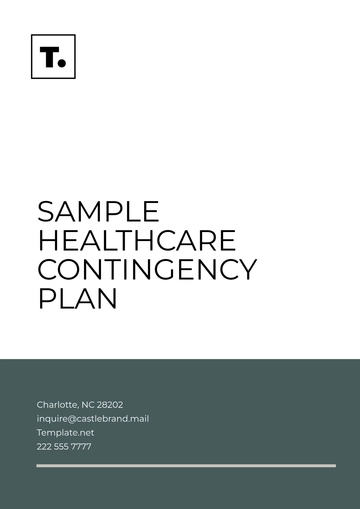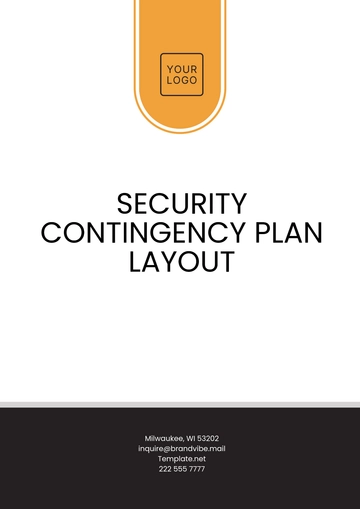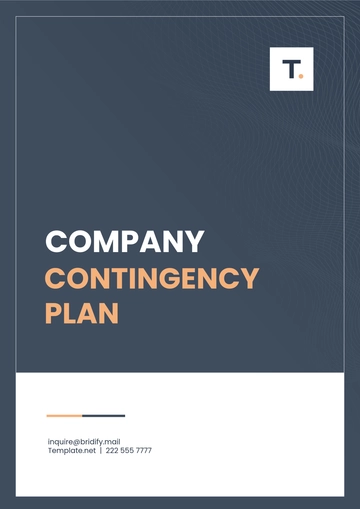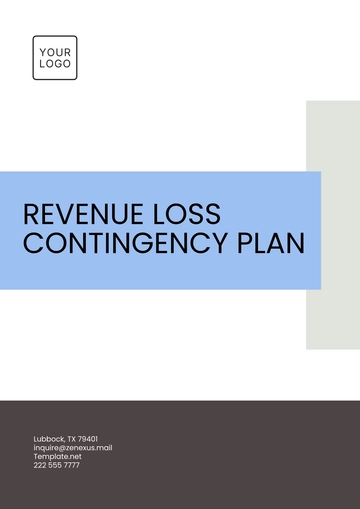Free Construction Contingency Plan

Project Name: Downtown Commercial Complex Development
Prepared By: [Your Name], Senior Project Manager
Prepared For: Horizon Builders Ltd.
Date: March 14, 2060
Revision Date: April 10, 2060
I. Introduction
The Construction Contingency Plan for the Downtown Commercial Complex Development is designed to address unexpected challenges and disruptions that may impact project success. This plan ensures the project remains:
On Schedule: Strategies to minimize time delays.
Within Budget: Allocated reserves to manage cost overruns.
Safe: Measures to protect workers, resources, and the environment.
Compliant: Solutions for regulatory and environmental concerns.
The contingency plan acts as a proactive roadmap for mitigating risks while safeguarding quality, efficiency, and stakeholder satisfaction.
II. Risk Assessment
A. Identified Risks and Scenarios
Risk Category | Specific Risks |
|---|---|
Budget Risks | Escalating costs of raw materials, labor shortages, currency inflation. |
Schedule Delays | Weather disruptions, supplier delays, unexpected design changes. |
Safety Risks | Falls, equipment malfunctions, worker injuries, and inadequate PPE usage. |
Environmental Risks | Hazardous soil, legal compliance delays, pollution concerns. |
Operational Risks | Equipment breakdowns, supply chain disruptions, workforce absenteeism. |
B. Risk Impact and Mitigation
Risk | Impact | Probability | Mitigation Strategies |
|---|---|---|---|
Escalating Material Costs | Project budget overshoot | High | Secure long-term contracts; utilize alternative suppliers. |
Weather Delays | Timeline slippage | Medium | Implement flexible schedules; monitor weather forecasts. |
Worker Safety Incidents | Project suspension | Medium | Regular training, safety audits, and strict PPE enforcement. |
Equipment Failure | Workflow disruption | Low | Schedule preventive maintenance; ensure backup machinery. |
III. Contingency Strategies
A. Budget Contingency Strategies
Reserve Allocation: Allocate twelve percent of the overall project budget, which amounts to two million four hundred thousand dollars, specifically for contingencies.
Cost Monitoring: You are encouraged to utilize the ProTrack Software to facilitate the process of monitoring expenses in real time as well as managing approvals efficiently.
Vendor Agreements: To minimize cost fluctuations, it is advisable to secure and stabilize prices by entering into binding agreements with your main suppliers.
B. Time Management Strategies
Flexible Scheduling: Include an additional 40 buffer days into the critical phases of the project, as outlined in the Project Schedule.
Material Stockpile: To avoid any potential delays in the supply chain, it is important to ensure that all essential materials are acquired no later than April 15, 2060.
Critical Path Adjustments: Weekly project meetings will focus on adjusting activities affecting the critical path.
C. Safety Management Strategies
Safety Protocol Enforcement:
Daily pre-shift toolbox talks to reinforce safety priorities.
Quarterly safety drills to prepare for emergencies.
Dedicated Safety Officer:
Sarah Bennett will conduct bi-weekly audits and issue corrective action reports.
Accident Contingency Fund: Allocate $100,000 for medical emergencies or safety compliance upgrades.
D. Environmental Risk Strategies
Conduct thorough environmental assessments by March 30, 2060.
Collaborate with environmental experts for quick cleanup if contamination is found.
Obtain all permits and regulatory approvals before May 1, 2060, to avoid delays.
IV. Resource Allocation
A. Financial Resource Plan
Resource | Allocated Amount | Purpose |
|---|---|---|
Contingency Reserve | $2,400,000 | To manage unforeseen costs. |
Equipment Rentals | $500,000 | Backup machinery in case of breakdown. |
Safety Measures | $150,000 | Training, audits, and safety equipment. |
Environmental Fund | $200,000 | Remediation and compliance solutions. |
B. Human Resource Assignments
Role | Name | Primary Responsibility |
|---|---|---|
Senior Project Manager | Rocky Orn | Oversee project execution and risk management. |
Safety Officer | Maria Turner | Conduct audits, and training, and ensure compliance. |
Procurement Lead | Jewell Ward | Manage materials, equipment, and contracts. |
Environmental Specialist | Lawrence Orn | Monitor and address environmental concerns. |
V. Communication Plan
A. Reporting Schedule
Daily Reports: On-site supervisors submit progress updates to the project manager.
Weekly Reports: Stakeholders receive detailed updates every Friday by 3:00 PM.
Monthly Meetings: Formal review meetings with stakeholders to discuss risks, budgets, and milestones.
B. Escalation Procedures
Level | Response Time | Point of Contact |
|---|---|---|
Minor Issues | 24 hours | Site Supervisors |
Major Risks | 48 hours | Senior Project Manager |
Critical Disruptions | Immediate Escalation | Executive Team and Board |
C. Communication Channels
Primary: Email, ProTrack Software for progress tracking.
Secondary: Project hotline for urgent updates.
VI. Budget and Cost Management
Expense Tracking: Use ProTrack Expense Logs to monitor spending against allocated budgets weekly.
Approval Threshold: All expenses exceeding $50,000 must be reviewed and approved by the Senior Project Manager.
Contingency Utilization Reports: Generate bi-weekly summaries detailing contingency usage and adjustments.
VII. Project Schedule Management
A. Key Project Phases and Buffer Allocation
Phase | Start Date | End Date | Buffer Days |
|---|---|---|---|
Site Preparation | March 20, 2060 | May 10, 2060 | 5 days |
Foundation Development | May 12, 2060 | August 5, 2060 | 7 days |
Structure Construction | August 10, 2060 | December 20, 2060 | 10 days |
Interior/Finishing Works | January 5, 2061 | April 15, 2061 | 8 days |
B. Critical Path Monitoring
Make use of ProTrack Scheduling Tools to oversee and track the various tasks that impact the timeline of the project. If any critical tasks experience delays that extend beyond three days, it will necessitate the implementation of immediate corrective measures to address the issue.
VIII. Plan Review and Revision
Monthly Review: Scheduled for the last Wednesday of every month to evaluate project risks and progress.
Revision Criteria: Changes will be made for:
New risks or challenges.
Budget or timeline deviations exceeding 5%.
Stakeholder feedback and project scope changes.
IX. Conclusion
This Construction Contingency Plan establishes a clear framework to proactively manage risks, maintain project momentum, and achieve successful completion of the Downtown Commercial Complex. By adhering to the strategies outlined, the project team will ensure on-time delivery, budget control, and safety compliance.
- 100% Customizable, free editor
- Access 1 Million+ Templates, photo’s & graphics
- Download or share as a template
- Click and replace photos, graphics, text, backgrounds
- Resize, crop, AI write & more
- Access advanced editor
Keep your construction projects on track with this Construction Contingency Plan Template. Designed for construction professionals, it helps you anticipate delays, budget overruns, and resource risks. Editable and customizable, this template ensures comprehensive planning to minimize disruptions. Access it now on Template.net and customize it effortlessly using our Ai Editor Tool to suit your project-specific requirements
You may also like
- Finance Plan
- Construction Plan
- Sales Plan
- Development Plan
- Career Plan
- Budget Plan
- HR Plan
- Education Plan
- Transition Plan
- Work Plan
- Training Plan
- Communication Plan
- Operation Plan
- Health And Safety Plan
- Strategy Plan
- Professional Development Plan
- Advertising Plan
- Risk Management Plan
- Restaurant Plan
- School Plan
- Nursing Home Patient Care Plan
- Nursing Care Plan
- Plan Event
- Startup Plan
- Social Media Plan
- Staffing Plan
- Annual Plan
- Content Plan
- Payment Plan
- Implementation Plan
- Hotel Plan
- Workout Plan
- Accounting Plan
- Campaign Plan
- Essay Plan
- 30 60 90 Day Plan
- Research Plan
- Recruitment Plan
- 90 Day Plan
- Quarterly Plan
- Emergency Plan
- 5 Year Plan
- Gym Plan
- Personal Plan
- IT and Software Plan
- Treatment Plan
- Real Estate Plan
- Law Firm Plan
- Healthcare Plan
- Improvement Plan
- Media Plan
- 5 Year Business Plan
- Learning Plan
- Marketing Campaign Plan
- Travel Agency Plan
- Cleaning Services Plan
- Interior Design Plan
- Performance Plan
- PR Plan
- Birth Plan
- Life Plan
- SEO Plan
- Disaster Recovery Plan
- Continuity Plan
- Launch Plan
- Legal Plan
- Behavior Plan
- Performance Improvement Plan
- Salon Plan
- Security Plan
- Security Management Plan
- Employee Development Plan
- Quality Plan
- Service Improvement Plan
- Growth Plan
- Incident Response Plan
- Basketball Plan
- Emergency Action Plan
- Product Launch Plan
- Spa Plan
- Employee Training Plan
- Data Analysis Plan
- Employee Action Plan
- Territory Plan
- Audit Plan
- Classroom Plan
- Activity Plan
- Parenting Plan
- Care Plan
- Project Execution Plan
- Exercise Plan
- Internship Plan
- Software Development Plan
- Continuous Improvement Plan
- Leave Plan
- 90 Day Sales Plan
- Advertising Agency Plan
- Employee Transition Plan
- Smart Action Plan
- Workplace Safety Plan
- Behavior Change Plan
- Contingency Plan
- Continuity of Operations Plan
- Health Plan
- Quality Control Plan
- Self Plan
- Sports Development Plan
- Change Management Plan
- Ecommerce Plan
- Personal Financial Plan
- Process Improvement Plan
- 30-60-90 Day Sales Plan
- Crisis Management Plan
- Engagement Plan
- Execution Plan
- Pandemic Plan
- Quality Assurance Plan
- Service Continuity Plan
- Agile Project Plan
- Fundraising Plan
- Job Transition Plan
- Asset Maintenance Plan
- Maintenance Plan
- Software Test Plan
- Staff Training and Development Plan
- 3 Year Plan
- Brand Activation Plan
- Release Plan
- Resource Plan
- Risk Mitigation Plan
- Teacher Plan
- 30 60 90 Day Plan for New Manager
- Food Safety Plan
- Food Truck Plan
- Hiring Plan
- Quality Management Plan
- Wellness Plan
- Behavior Intervention Plan
- Bonus Plan
- Investment Plan
- Maternity Leave Plan
- Pandemic Response Plan
- Succession Planning
- Coaching Plan
- Configuration Management Plan
- Remote Work Plan
- Self Care Plan
- Teaching Plan
- 100-Day Plan
- HACCP Plan
- Student Plan
- Sustainability Plan
- 30 60 90 Day Plan for Interview
- Access Plan
- Site Specific Safety Plan





























